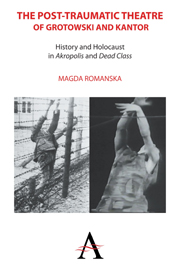 The Post-traumatic Theatre of Grotowski and Kantor
The Post-traumatic Theatre of Grotowski and Kantor Book contents
- Frontmatter
- Contents
- Foreword by Kathleen Cioffi
- Preface
- Acknowledgments
- List of Illustrations
- Introduction
- Part I Our Auschwitz: Grotowski's Akropolis
- Part II Our Memory: Kantor's Dead Class
- Chapter 22 Tadeusz Kantor: A Very Short Introduction
- Chapter 23 Dead Class: The Making of the Legend
- Chapter 24 Dead Class in Poland
- Chapter 25 The Polish History Lesson
- Chapter 26 Dead Class Abroad
- Chapter 27 On Not Knowing Polish, Again
- Chapter 28 The Visual and the Puerile
- Chapter 29 The National and the Transnational
- Chapter 30 Witkiewicz's Tumor
- Chapter 31 An Age of Genius: Bruno Schulz and the Return to Childhood
- Chapter 32 Conversing with Gombrowicz: The Dead, the Funny, the Sacred and the Profane
- Chapter 33 Panirony: “A pain with a smile and a shrug”
- Chapter 34 Raising the Dead
- Chapter 35 Dead Class as Kaddish…
- Chapter 36 Dead Class as Dybbuk, or the Absence
- Chapter 37 The Dead and the Marionettes
- Chapter 38 Men and Objects
- Chapter 39 Dead Class as Forefathers' Eve
- Chapter 40 Dead Class: The Afterlife
- Postscript
- Appendix
- Notes
- Bibliography
- Index
Chapter 22 - Tadeusz Kantor: A Very Short Introduction
from Part II - Our Memory: Kantor's Dead Class
- Frontmatter
- Contents
- Foreword by Kathleen Cioffi
- Preface
- Acknowledgments
- List of Illustrations
- Introduction
- Part I Our Auschwitz: Grotowski's Akropolis
- Part II Our Memory: Kantor's Dead Class
- Chapter 22 Tadeusz Kantor: A Very Short Introduction
- Chapter 23 Dead Class: The Making of the Legend
- Chapter 24 Dead Class in Poland
- Chapter 25 The Polish History Lesson
- Chapter 26 Dead Class Abroad
- Chapter 27 On Not Knowing Polish, Again
- Chapter 28 The Visual and the Puerile
- Chapter 29 The National and the Transnational
- Chapter 30 Witkiewicz's Tumor
- Chapter 31 An Age of Genius: Bruno Schulz and the Return to Childhood
- Chapter 32 Conversing with Gombrowicz: The Dead, the Funny, the Sacred and the Profane
- Chapter 33 Panirony: “A pain with a smile and a shrug”
- Chapter 34 Raising the Dead
- Chapter 35 Dead Class as Kaddish…
- Chapter 36 Dead Class as Dybbuk, or the Absence
- Chapter 37 The Dead and the Marionettes
- Chapter 38 Men and Objects
- Chapter 39 Dead Class as Forefathers' Eve
- Chapter 40 Dead Class: The Afterlife
- Postscript
- Appendix
- Notes
- Bibliography
- Index
Summary
Born in 1915 in Wielopole Skrzyńskie, a small Polish-Jewish town in Southern Poland, Tadeusz Kantor grew up in a world dominated by both Christian and Jewish mysticism. Today, in the house where Kantor was born, there is a small museum, with souvenirs from his childhood and props and drawings from his spectacles. During his childhood, every aspect of daily village existence, from birth to death, had religious ramifications that were imminently embedded within the entire sociocultural context of each congregation. The two worlds, Kantor remembers, “lived in an agreeable symbiosis,” each cultivating its own traditions. The synagogue and the church stood on opposite sides of the city; Jewish and Christian ceremonies were performed parallel to each other. Ruled by the cycles of their religious rituals, each community was oriented more towards sacred than earthly values. As Kantor reminisces, “beyond its everyday life, the little town was turned towards eternity.” The coexistence and intermingling of the two cultures, and the spiritually charged atmosphere of timelessness and mysticism they evoked, were resurrected time after time in all of Kantor's spectacles. The town – constructed like a theatrical space in which the predictable intertwined with the accidental, the grotesque with the profound, the sacred with the profane – became the framework for the juxtapositions Kantor investigated over years of theatrical experiments. Built around the everlasting oppositions between life and death, form and matter, illusion and reality, consciousness and object, Kantor's “religious dramas” attempt to simultaneously reconcile these poles and show the impossibility of doing so.
- Type
- Chapter
- Information
- The Post-traumatic Theatre of Grotowski and KantorHistory and Holocaust in 'Akropolis' and 'Dead Class', pp. 185 - 192Publisher: Anthem PressPrint publication year: 2012
